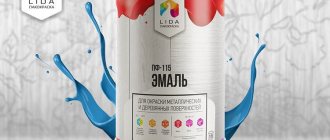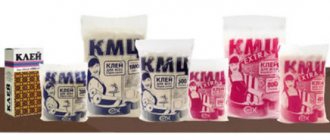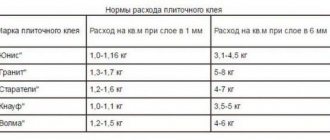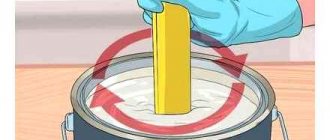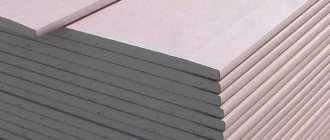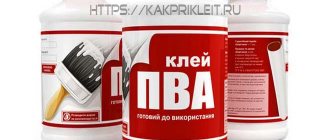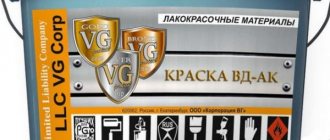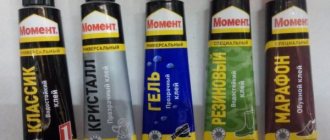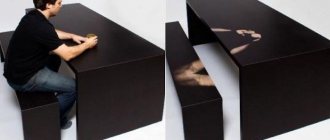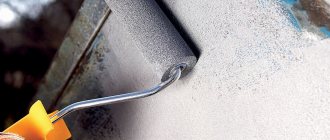Bustilat glue is often used in repairs and construction. The scope of its application is very wide, as it is suitable for gluing different surfaces. The composition has maintained its popularity on the market for more than half a century, despite the spread of modern mixtures.
Use Bustilat glue to connect the following objects:
- wooden crafts;
- parquet;
- carpet;
- wallpaper;
- asbestos-cement elements;
- tile;
- linoleum.
To improve technical characteristics during production, chalk, water, carboxymethylcellulose and other components are added to the glue. Glue manufactured in accordance with GOST requirements does not contain harmful elements.
The technical characteristics of Bustilat include:
- the color of the glue is at first light gray or white, and as it hardens it turns out to be completely transparent;
- per square meter of surface requires 0.1-0.2 kg of mixture;
- complete hardening time is 24 hours;
- the composition is not flammable, since it contains no alcohols;
- Only in the warm season is it suitable for outdoor work (since it is water-based and freezes in the cold), but can be used indoors all year round.
It is mainly used for fixing wallpaper; it is also used to solve many other problems. In trade, glue is presented in containers of different sizes in the form of bottles or cans.
Recommendations for use
Before performing gluing work, it is necessary to ensure the room is ventilated by opening windows and doors.
The working base must be prepared by clearing it of dirt and dust. When the surface has a porous structure, it is recommended to pre-prime it with a specialized composition.
Below is the procedure for working with materials for which Bustilat is most often used for fastening.
Linoleum
- When gluing carpet or linoleum, the adhesive mixture is applied to the floor with a spatula. Then the coating is gradually laid on it.
- It is necessary to thoroughly press it to the surface and leave it for about three days to dry.
- In this case, the glue consumption is approximately 0.5-0.7 kg per square.
Tip To speed up the hardening of the adhesive when attaching tiles or linoleum, add a cement solution (1:1) prepared from one part cement and three parts sand.
Tile
- When using Bustilat for wall cladding, it should be applied to the back side of the tiles in a small layer, approximately 2-3 mm.
- Then the cladding elements should be pressed well onto the wall surface.
- The drying process will take up to three days (72 hours), and glue will be consumed from 0.4 to 1 kg per square meter.
- If Bustilat has become thicker over time, then for attaching wallpaper it can be diluted by adding a seventh of water, but no more. Fresh glue does not need to be diluted.
- The composition is applied to the wallpaper or to the wallpaper and the wall if heavy varieties are installed.
- With this use, glue is consumed at a rate of 0.3 to 0.4 kg per square meter.
What is Bustilat
This Bustilat adhesive standard was developed in accordance with GOST and TU. The manufacturer has added biocidal substances to the glue, which create an obstacle to the formation of mold and fungi on surfaces, especially natural ones such as wood and woven fabrics. The structure of the adhesive base is similar to thick sour cream. Composition of white or unobtrusive beige color.
Components that make up the glue:
- latex;
- chalk;
- water;
- additives and preservatives;
- thickener carboxymethylcellulose.
The composition has increased elasticity and ensures a strong connection of the glued materials for a long service life. Technical characteristics of Bustilat glue:
- has low shrinkage;
- dries completely in 1-2 days;
- does not contain solvents;
- the strength of the adhesive connection, due to which a reliable aesthetic seam is formed on the surface where it was applied;
- durable elastic composition can be used in rooms with high humidity;
- high-adhesive glue is environmentally friendly;
- after its use, there is no need to ventilate the room for a long time, since the composition is odorless;
- Due to its high adhesive force, it can be used for gluing parts made of wood or synthetic materials.
It is recommended to store Bustilat at temperatures from +5°C to +25°C, out of direct sunlight and away from heating devices. The average glue consumption is 0.7 - 1.0 kg/m². It is packaged in plastic jars of 1 kg or 2.6 kg, as well as in plastic buckets of 14 kg.
What is the difference between Bustilat and PVA
These two popular adhesives have differences in composition and technical characteristics.
They are used to fasten the same elements and materials. Its popularity is due to its low cost and fairly high efficiency. However, there are some differences between them:
- the shelf life of Bustilat is longer than that of PVA (one year and six months, respectively);
- PVA is more environmentally friendly, it is acceptable for repairs in kindergartens and schools;
- Bustilat's adhesion is slightly higher than that of PVA.
In general, the two adhesive compositions differ insignificantly, so both are suitable for repairs.
Advantages, disadvantages, characteristics
The popularity of the glue is due to the combination of reasonable price and high performance characteristics. Among the main ones:
• inertness to humid environments;
• absence of unpleasant odor;
• safe composition for human health;
• high adhesive qualities.
After the adhesive mixture dries, a reliable, aesthetic seam is formed on the surface to be treated.
The disadvantages of the glue are relative, rather related to a comparison of the composition with more modern products. Significant disadvantages:
• impossibility of use at sub-zero temperatures;
• limited range of applications.
Types of "Bustilat"
The glue has practically no analogues, taking into account the ratio of cost and quality. Several modernized types of this adhesive substance are known.
Varieties of Bustilat glue differ in the following parameters:
- heat resistance;
- frost resistance;
- moisture resistance.
Here are the most popular types of glue:
- Bustilat-M. Characterized by resistance to frost. Suitable for working with synthetic carpet, vinyl wallpaper, tiles, linoleum. Often they are used to prime external and internal walls of premises.
- Bustilat-N. Used for fastening borders, thick wallpaper, linoleum without a base and tiles. Characterized by excellent waterproofing qualities. To achieve the desired consistency, the glue should first be diluted with water according to the instructions.
- Bustilat-D-Super. The distinctive features of this composition include low toxicity, high adhesion and non-flammability. It is most suitable for attaching linoleum, as well as wallpaper.
- Bustilat-Lux. Designed for connecting finishing elements based on polymer materials (wallpaper, linoleum and PVC film). It is widely used in the construction industry, as well as by joiners and carpenters.
Bustilat - technical characteristics of glue and application
Bustilat glue is known to many people, as it has been used for more than half a century.
Its area of application is quite extensive - construction and repair, where I use it for gluing various surfaces. Every year new materials appear on the construction market, but Bustilat still remains a very popular synthetic material.
Glue bustilate
Where nails, staples and screws cannot be used , adhesives are used . They are able to easily connect walls, floors and ceilings with various decorative elements, while all the material remains undamaged and without holes.
The most valuable are universal adhesive mixtures that are capable of gluing wallpaper, floor coverings and decorative elements made of different materials. This type of glue also includes bustylate, the quality characteristics of which were perfectly demonstrated in laying linoleum.
Purpose
During construction and renovation, adhesives are required that can firmly fix the coating. In addition to PVA, Bustilat also has this composition. You can use it to glue:
- synthetic coverings with pile;
- ceramic tiles;
- polymer tiles;
- linoleum with felt or fabric base;
- wallpaper;
- parquet;
- carpet;
- wooden elements;
- asbestos cement products.
Glue is used to fix various decorative elements on a plastered surface, provided that it is located indoors.
Compound
To make glue in production , manufacturers use:
- latex;
- chalk;
- thickener;
- modified cellulose;
- water;
- additional impurities.
There are no toxic substances or alcohol, so Bustilate is absolutely harmless to humans. It is this quality that makes it in demand when carrying out interior work.
Features and Specifications
The consistency of the adhesive composition is a thick creamy mass, without a pungent odor, with a grayish-white color. Dried glue is not visible at all on surfaces, as it becomes transparent.
Bustilate, like PVA, is considered an environmentally friendly material; in addition, it dries quickly, and the joints are made especially strong. Its advantages include:
- Economical. Depending on the surface material, it is consumed from 100 to 200 grams per square meter.
- It dries completely only after 24 hours.
- If some error is noticed and the glue has not yet dried, then everything can be corrected. At the same time, there is no need to reapply a layer of glue to the surface.
- The material for which this glue is used does not stain even after the glue has completely hardened.
- The material is non-flammable, as it contains no alcohol.
Having such excellent characteristics, Bustilat has deservedly gained a reputation as a universal one. But besides its advantages, it also has disadvantages:
- modern multicomponent mixtures have surpassed Bustilat in terms of service life;
- it cannot be used in an unheated room as it freezes quickly. And all because it contains water. When the glue has completely hardened, then it does not react in any way to low temperatures.
Not so long ago it was most often used for wallpapering walls. But it can solve many other problems.
Bustilat glue can be found on sale in cans and bottles of various sizes.
Types of glue
The chemical industry does not stand still. Modern compounds are added to many formulations of drugs that are used in everyday life. The famous glue has also undergone changes. To improve its moisture resistance and frost resistance, special additives were added to its composition.
Depending on the use of the adhesive composition, its varieties are distinguished:
- "Bustilat-M" - the adhesive composition includes frost-resistant additives. Used as a primer and adhesive. Linoleum, carpeting, various types of tiles and wallpaper are glued.
- Bustilat-N is specially designed for materials with poor adhesion. It contains special additives that increase the adhesiveness and strength of the adhesive joint. It is used for gluing linoleum without a base, synthetic carpets, non-woven wallpaper, etc.
- "Bustilat-D-super" - has enhanced strength. It is specially used if you need to secure heavy materials or for gluing linoleum to a base.
- “Bustilat-Lux” - this type is intended for joining polymer materials: PVC film, linoleum, etc.
One type of glue may have different numerical values, which indicate the degree to which the main distinctive property is manifested. Thanks to its varieties, all repair and finishing work can be completely done. It is worth considering that if Bustilat is used for linoleum and other various elements, it will cost much less than other modern substances. This fact remains very important; This glue simply has no competitors in this sector.
Bustilat glue: application
Before using the adhesive composition, you need to carefully prepare the surface:
- remove dust and dirt from the surface;
- if necessary, the surface can be washed;
- if the surface is porous, then it needs to be opened with a primer;
- the room temperature should be above zero;
- Prepare the glue by mixing it thoroughly.
Working with floor coverings
To glue linoleum or carpet to the floor, you need to apply a thin layer of the adhesive mixture to the floor using a spatula. The prepared, straightened coating is carefully laid according to its dimensions on the floor covered with glue.
Every centimeter of the covering is carefully pressed to the floor and smoothed out. It is advisable not to enter this room for 72 hours to allow the glue to dry completely. To glue the floor covering, you need to know that the consumption of the adhesive mixture for such work is 500–700 grams per square meter.
Laying tiles
To lay tiles on the wall, you need to put 1-3 mm of the compound on the back side of it. Depending on the condition of the wall, you may also need to apply an adhesive composition to it.
Align the tile and lightly press it against the wall. It is advisable not to touch this surface for 72 hours so that the adhesive layer is completely dry. And the glue consumption per square meter ranges from 400 to 1000 grams.
Wallpapering
If you have just opened the glue, then you do not need to dilute it with water.
And if you have already opened it and thickened a little, then it is advisable to dilute it. The homogeneous mass obtained after mixing is applied in an even layer to both surfaces using a brush or roller. Ten minutes, after that, you just need to wait, and then glue the surfaces. You need to get rid of all air bubbles using a dry towel or a special spatula. There should be no drafts in the room where the work was carried out. It is advisable to close the room for the whole day. The consumption of bustilate for wallpapering a room will be 300–400 grams per square meter. You can also use PVA adhesive.
Conclusion
Bustilat glue has been known to people for a very long time. It is reliable, durable, and most importantly - inexpensive material, which is used for gluing wallpaper, linoleum and other various materials. The main condition when working with it is positive temperature in the room .
What does bustylate glue look like?
instrument.guru
How to clean the surface from old Bustilat
If it is necessary to dismantle the old wallpaper that was attached to Bustilat and free the surface from glue residues, preparation is required. Frozen “Bustilat” does not dissolve even in hot water, so you should not soak it.
The most effective method is mechanical, using a sharp scraper or spatula.
A grinder with a special attachment in the form of a metal brush removes residues perfectly. A respirator is required to protect against dust.
There is another method for removing dried glue. Moisten a cloth with water, then apply it to the base and heat it with an iron or hairdryer. The adhesive crust will become softer and easier to remove with a spatula. The process is long, but not dusty.
Bustilat glue is very popular, and if you use it correctly, you will achieve good results in home repairs.
Often during repairs there are times when it is not possible to carry out facing work mechanically. Then they resort to gluing materials and decorative elements to various bases. For such work, universal adhesive compositions are valuable, but Bustilat glue can cope with such tasks. Before use, you must read the terms of use.
PVA primer for waste-free and cheap repairs
Currently, any hardware store offers to purchase specially prepared primer compositions, however, if a person wants to save money and get a good result, he can always try out how a PVA primer will cope with the task, and it can be done at home.
Read also: How to replace the battery for a screwdriver
1 Why shouldn’t you neglect amateur activities?
Every person faced with the need to carry out repairs knows that priming walls is one of the mandatory stages of surface preparation. Penetrating into small cracks in the surface, the primer holds it together and also allows for the application of various compounds in the future, be it paint or varnish. It is this option of carrying out repairs in several stages that guarantees the durability of the work.
The composition of a homemade PVA primer helps reduce the cost of purchasing paint. Due to the fact that the surface becomes smooth and interacts well with new layers, there is no need to paint in several layers.
Those who are just beginning to acquire construction skills may doubt the reliability of such methods, they say, when you do it yourself, there are more mistakes. But this is not the case, everything is done extremely simply, and no chemical education is required.
2 How to prepare a PVA primer?
In order to prepare the primer yourself, you need to take the well-known PVA glue and dilute it in water. Experts do not recommend resorting to this method if you need to treat a large surface, but in small areas you can get by with an adhesive base.
By diluting the composition at the rate of 2 parts water to 1 part glue, you can obtain a liquid mass that is quite easily applied to the surface and leaves a whitish layer. Naturally, a self-prepared primer will not have all the qualities of a professional composition, however, if after the repair there is a large supply of glue left, it can be used in practice.
Professional compounds can provide reliable protection against mold formation, while glue simply helps make the surface more receptive to the application of new layers of paint and varnish.
As mentioned earlier, preparing the composition is quite simple. You should not prepare too much solution; after standing for a long time, its bonding qualities noticeably deteriorate. It should be understood that a do-it-yourself primer will always be lower in quality than special compounds.
3 A few more tricks for a successful repair
To improve the quality of the primer, you can always add crushed chalk or a little liquid resin to the composition. The adhesive composition is perfect for treating walls that will be decorated with wallpaper, however, proper preparation of a primer, the basis of which is PVA, can give a fairly good result.
The main difference between an adhesive primer is that it is not absorbed into the surface, does not fill small cracks and gaps, but simply forms a film. Given the fact that variance gives the best result, you can weigh the pros and cons of the economical option.
It is best to prepare the composition in a warm room, far from balconies and fire. Depending on the required volume of the finished composition, take a bucket or any other open container. Glue is gradually poured into it, and water is added to it.
It is very important to carry out mixing while simultaneously working with a stick or a special spatula; the water should quickly dilute the glue, but not remain on its surface as a separate layer. If the question arises of what to replace the primer with, you can always start working with PVA.
The classic proportion is 2 parts water to 1 part glue, however, if a person needs to get a thinner or thicker composition, he can change the proportions. The introduction of chalk or resins should be done “by eye”, carefully adding elements to the finished mass.
Not forgetting the rule of constant stirring, in the end you can get an excellent building material, the quality of which is close to professional mixtures sold in specialized stores.
What it is
Bustilat has occupied a selling position on the market for more than 50 years, despite the production of a large number of specialized adhesive compositions.
It looks like a mass of creamy consistency, based on latex. Chalk, water, carboxymethylcellulose (thickener), and modifiers are added to the composition, giving the composition improved properties.
According to GOST, Bustilat does not contain alcohol additives, toxins, or volatile impurities that are harmful to the body. Thanks to safety, buyers make their choice towards this product, especially if the work is carried out inside a residential premises.
Advantages
The main positive characteristics of the glue are:
- environmental Safety;
- practicality;
- low cost;
- availability;
- time-tested reliability.
Bustilate is a practically universal adhesive composition for use in interior work.
Technical characteristics of the adhesive composition
The main technical characteristics of Bustilat glue include:
- Average consumption per 1 m2 is 80–250 g.
- The temperature for drying should be maintained at about 20 degrees.
- Surface adhesion is achieved in 1–1.5 days.
- The initial shade of the mass is white, light gray, but after complete drying the layer becomes transparent.
- Does not penetrate even very thin coatings.
- Non-fire hazardous as there are no alcohol additives.
- It is permissible to carry out outdoor work in warm, dry weather, since the mass is water-based and freezing will occur in the cold.
- Interior work is carried out all year round.
Bustilat adhesive mass is produced in plastic containers (bottles, jars, buckets) weighing 1–18 kg.
The product fixes the following materials:
- products made of wood, asbestos cement;
- synthetic materials;
- ceramics;
- wallpaper;
- linoleum with different bases;
- tile;
- carpet
Indoors, it is allowed to fix decorative elements on the plaster plane.
Technical characteristics are improved by adding impurities to the composition.
Glue Features
Bustilate exhibits high adhesive properties with respect to many building materials, in particular: fabrics, wood, concrete, and polymers. After polymerization, it forms a durable thin film without a specific color. The product is economical in consumption. For every square meter it takes 100-180 grams. The duration of complete drying is 28-36 hours, depending on the humidity level of the room in which the repair was carried out. The long polymerization process makes it possible to eliminate installation flaws, correct the canvas, and adjust the joints. For 1 year, the glue in an uncorked container retains its properties, so the remaining product can be used for its intended purpose.
Advantages and disadvantages
Bustilat glue has its positive aspects in use:
- An environmentally friendly product, you can use it safely inside your living room.
- Availability of raw materials (every hardware store has this product).
- The cheapness of the initial raw materials for production makes the glue itself cheap.
- Practical, reliable adhesion of various materials.
- Versatility, which allows you to use only one product during repairs (instead of a primer or waterproofing mixture).
- Flexibility of the connection, which is very important if the product is likely to be subject to deformation.
- There is virtually no shrinkage.
- The seam is smooth and transparent.
No disadvantages have been identified in the use of Bustilat, but it may be inferior in characteristics and service life to modern adhesive bases.
If we take into account price and quality, then this material has no analogues. Only more modernized types have been released. In terms of parameters, they differ in thermal, frost, and moisture resistance.
- “Lux” – gluing of polymer materials.
- “M” – adhesive for tiles, wallpaper, carpets. It has excellent adhesion to various planes of walls and floors. Used as a primer material.
- “N” – bustylate for linoleum, heavy wallpaper, synthetic coating. The seam remains flexible after drying.
- “D” is a mixture for adhesive-polymer raw materials with a smooth base.
- "Omega" - glue is used in the process of covering the floor with carpet.
General information about Bustilat
Bustilat is a universal construction adhesive of synthetic origin. Good adhesion indicators and harmlessness to health are the main qualities that make it suitable for use inside human housing. The glue cannot be used outdoors, but indoors it is used for finishing walls, floors, and ceilings, allowing you to securely fasten decorative elements and avoid drilling unnecessary holes. “Bustilat” is an invention of Russian scientists from the Mosstroy Research Institute, but now it is produced by different companies:
- "Bright colors";
- VGT;
- "Expert";
- "Aquest";
- "Rhoda Color";
- "Satellite";
- "Akvit";
- "Diola", etc.
The most popular glue remains Lakra M 20 from, which can be found in any hardware store. High-quality glue always has a certificate of conformity. Many companies produce glue in accordance with GOST 24064-80, but its production is also permitted according to specially developed specifications.
Famous manufacturers
Since Bustilat is in demand today, almost all manufacturers of adhesive masses are engaged in its production. But three TMs are more often found in customer reviews:
- Lakra produces Bustilat M-20. Designed for gluing synthetic carpets, linoleum, tiles, and wooden floors indoors. Used diluted as a primer. If it begins to thicken during storage, then dilution by 10% with water is acceptable. After the layer has completely dried, a flexible film is formed. Packaged in containers of 1 and 2.5 kg.
What and how to remove
Often during repairs it is necessary to remove the old coating. If it was glued with bustylate, then some nuances must be taken into account: the frozen material forms an elastic film that is not washed off with water. Therefore, to remove the old coating they resort to mechanical methods. To do this, use a sharp spatula or scraper.
You can also use the heating method. To do this, use an iron or hair dryer. For the first option, the fabric is applied to the surface of the wallpaper and ironed. In the second, the surface is simply heated with a hot air stream. With this effect, the adhesive layer will soften, which can be easily removed with a spatula.
The mechanical method also includes a drill with an attachment. But this method generates a lot of dust, which will contaminate the surfaces. With this option, you need to use respiratory protection.
Features of application
Before purchasing bustylate glue, read the instructions. It is simple and understandable to any consumer. Moreover, the manufacturer of this product, for the convenience of consumers, places recommendations in each product package.
Before starting work, it is necessary to carefully prepare the surface to be treated. It must be thoroughly cleaned of plaster, dust and other contaminants. Then the area must be leveled using putty until smooth. In order for the glue to adhere well to the surfaces, the base must be treated with a primer. In this way you can also protect the area from attack by various fungi.
Before applying boostilate to the surface, it is necessary to mix it well. The process of applying adhesive to flooring and wallpaper does not require any special skill. Using an appropriate brush size, the glue is applied to the main surface and to the product to be glued. After this, let the glue dry for a few minutes, and then combine the two prepared surfaces. It is very important to ensure that no air bubbles form between the products. To do this, you need to press the area well with a dry cloth. The glue dries for at least a day, and all windows in the room must be closed.
Tips for use
Using some tips, the gluing job will go faster and easier:
- During storage, the glue may delaminate. Before use, you must mix thoroughly, otherwise the properties of the material will not appear.
- While working, you must wear protective equipment.
- The mass is applied to a plane using a convenient tool: a brush, a notched spatula.
- The surfaces to be glued must be thoroughly cleaned of dirt and degreased.
- The declared properties will appear after 72 hours after gluing.
- If tiles are glued, then the mixture is applied to it in a layer of at least 3 mm, and if carpet is applied - to the floor.
To make the adhesive mass harden faster when gluing the tiles, add cement mortar to it in a ratio of 1*1. The solution itself is prepared from part cement and three parts sand.
Application of bustylate glue
Bustilat glue is most often used for linoleum and wallpaper. Taking into account the specific operational characteristics, before use it is necessary:
- Remove dirt from the surface to be pasted.
- Cover the porous surface with a primer.
- Make sure the room temperature is above zero.
- Mix the glue thoroughly.
The procedure for wallpapering does not differ from the usual algorithm. Installing linoleum coverings using Bustilat glue is also not difficult. The prepared linoleum glue is applied to the surface. To avoid swelling, before laying the glued linoleum, you need to get rid of air bubbles from the adhesive layer using a special roller or brush. The coating is pressed tightly for a day (time for the adhesive to harden).
When working with bustylate, follow the adhesive manufacturer's instructions.
Subject to compliance with all rules of use, Bustilat, taking into account its availability and low price, is practically in no way inferior to modern compounds, and in some cases regains its position as one of the best universal adhesives of domestic production.
- Compound
- Types of glue
- 1. Bustilat Lux
- 2. Bustilat M
- 3. Bustilat N
- 4. Bustilat D
- 5. Bustilat Omega
- Application of Bustilat
- Advantages
- Flaws
What's included
The composition of this adhesive includes chalk, latex, thickener, cellulose, and water. Various impurities may also be present that improve the composition.
The technical specifications are as follows:
- has a white color;
- viscous, without the presence of lumps;
- after it dries, it acquires a transparent color;
- has low consumption;
- hardens within 24 hours;
- non-flammable, as it does not contain alcohol;
- should be used only in the warm season, because it is water-based and freezes in the cold.
The glue can be used for wallpaper, linoleum, parquet, tiles, and wooden products.
Compound
This adhesive contains latex with the addition of chalk, carboxymethylcellulose thickener, water and additional elements. It is worth noting that GOST does not allow this mixture to contain any harmful or toxic substances. In addition, given that the glue is used for indoor work, it does not contain any volatile substances.
Therefore, boostilate does not pose a threat to human health at all. In addition, the adhesive does not contain alcohol, so it is not afraid of fire. Before going to the market, all products are tested in special laboratories for quality, after which the glue receives a certificate.
Today you can buy not only traditional glue, which has been produced for many years, but also a lot of its varieties, more improved and differing in properties. Each type has a different degree of frost resistance, susceptibility to different temperature conditions and other advantages.
The low consumption of bustylate glue also attracts consumers. To apply one layer of glue you will need only 100-200 g of glue per 1 square meter, depending on the type of material. In addition, complete drying of the product occurs at room temperature after 20-34 hours.
Varieties
You can find different types of glue on the market. The choice will depend on what types of work will be carried out. Below are the main types of adhesive composition.
- "Omega". This type is used for fabric or felt material. For example, it will perfectly stick fabric wallpaper to the wall. In this case, there will be no stains, since the substance will not penetrate deep into the fabric. Perfect for working with paper. It will help to glue a broken tile or a broken wooden object.
- "Bustilat-M". Capable of gluing concrete, brick, ceramics. Will withstand very low temperatures. Used when finishing tiles and wallpaper, can stick linoleum. This glue is perfect for wood. Sometimes used when priming walls.
- "Bustilat-N". It has excellent elasticity and retains its adhesive properties even when the object is deformed. Can adhere to materials that do not adhere well. For example, these include synthetic coatings.
- "Bustilat-D-super." Prevents the development of mold in the material. This adhesive can be used to attach vinyl linoleum. It is also suitable for polymer materials with a smooth surface. This substance is non-toxic and safe. There is no difference between the expensive adhesive and Bustilat-D-super. He copes well with his tasks.
- "Lux". Used for materials with a polymer base. This includes siding.
Areas of application of Bustilat
Glue is used for arranging various coatings inside the house if strong fixation of finishing materials is required. Thanks to its elasticity, the adhesive seam will serve for a long time, because it is not subject to destruction due to vibrations, fluctuations, and mechanical loads. The product is perfect for the following reasons:
- concrete;
- wood;
- bricks;
- Fibreboard, chipboard;
- stone;
- plaster.
Bustilat is used to glue various types of wallpaper, including the heaviest ones. It is suitable for fixing carpet, other pile coverings, linoleum with a fabric and felt backing. The adhesive is suitable for fastening polymer and ceramic tiles, panels, stucco moldings, baguettes and other decor, wood trim. The glue is also useful for working with asbestos-cement slabs. Another product is added to cement during various repair work, which will increase the strength of the mortar or screed.
Usage
The surfaces to be glued must be prepared. They are cleaned of dust and dirt residues. The porous surface is primed using a special solution.
Important! Before starting work, you need to check how well the room is ventilated, but after work you will have to close all windows and doors.
The consumption of adhesive for carpet or linoleum will be approximately 700 g per sq.m. It is applied to the floor, and a coating is placed on top and pressed. The surfaces will take 72 hours to dry. If you need to speed up the drying process, add a cement solution to the glue. The proportion should be 1 to 1.
If you need to glue the tile, then the product is applied to its back side in a thin layer. The consumption will be about 1000 g.
For wallpaper, glue is not diluted. If it thickens, add a little water. The main thing is not to overdo it. Per sq. m. consumption of adhesive composition will be about 200 g.
Important! It is imperative to prevent air bubbles from appearing between objects. While they dry, the windows in the room should be closed, and there should be no drafts.
The composition of Bustilat glue includes chemical compounds, so you need to work with it, observing the basic rules. Be sure to wear gloves before use. When the glue dries, the room needs to be ventilated. In case of contact with mucous membranes, they should be washed thoroughly. If any unpleasant symptoms appear, be sure to visit a doctor.
To find out more watch the video:
Flaws
Bustilat does not have any particular disadvantages in its field of application. May be inferior to some modern analogues in terms of durability.
To summarize, we can say that Bustilat is a reliable and inexpensive adhesive ideal for gluing wallpaper, linoleum and many other materials used in interior decoration.
During repairs, it is impossible to do without adhesives. This is justified by the fact that the use of elements such as nails or screws can make the material unsightly. In order not to spoil the appearance of the room after renovation, they often use Bustilate Glue: we will find out the main properties and use cases below.
The glue is used for gluing wooden and ceramic products, wallpaper, linoleum and other structures. It is worth noting that this substance has been on the market for about 50 years, however, even today the use of bustylate glue has not lost its popularity. This proves that boostilate is a high-quality material that is available to any category of builders, as well as to those people who do their own repairs.
Removing old glue
Sometimes you have to remove the remaining glue. For example, when old wallpaper is removed. If you try to soak Bustilat, nothing will work.
It can be removed with a grinder using a brush attachment. But in this case there will be a lot of dust, so you can’t do without a respirator. It is better to use a scraper or spatula to remove it.
If you don't want dust to appear, you can try another method. This method will take more time. Take a wet cloth and apply it to the surface. Then it is ironed or heated with a hairdryer. When the glue softens, remove it with a spatula.
Find out more information from the video:
